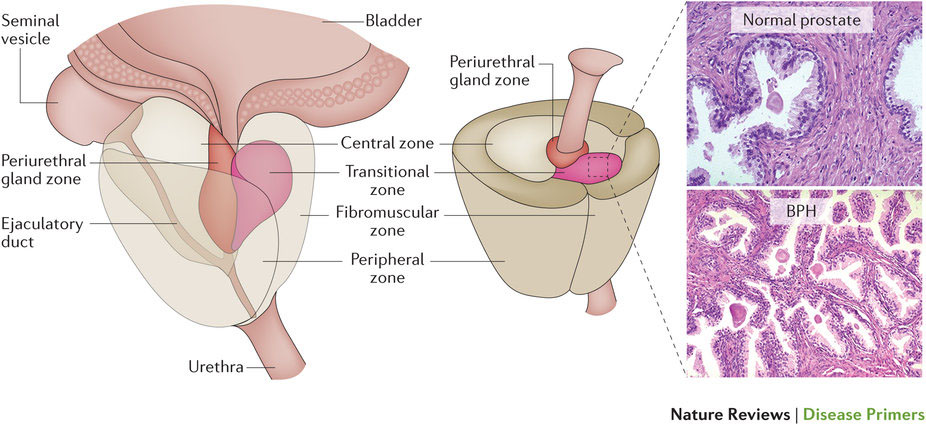Review Abstract
前立腺肥大症
Benign prostatic hyperplasia
2016年5月5日 Nature Reviews Disease Primers Article number: 16031 (2016) doi: 10.1038/nrdp.2016.31

前立腺肥大症(BPH)は下部尿路症状(LUTS)の原因になり、高齢男性集団に診断されることが多く有病率も上昇している。修正可能と修正不能の別を問わず多くのリスク因子がBPHおよびLUTSの発症と進行のリスク上昇を招く。閉塞性症状(排尿遅延、尿勢低下、腹圧排尿、苒延性排尿など)あるいは刺激性症状(頻尿、尿意逼迫、夜間頻尿、切迫性尿失禁、尿量低下など)が症状として現れることがあり、患者の排尿後に影響(排尿後尿漏れ、残尿感など)が及ぶ場合もある。前立腺肥大の原因となる炎症や性ホルモンの影響を受けると考えられるプロセスによって、移行帯の前立腺間質細胞および上皮細胞の両方が増殖するとBPHが発症する。LUTSのある患者には、BPHと診断される前にいくつかの主要な診断的治療が行われる。BPH男性の治療オプションは、経過観察に始まり、内科的治療を経て外科的治療へと進められる。大多数の患者では、その症状と障害の大きさによって、どの治療から開始すべきかが決定される。
PrimeView
前立腺が肥大する前立腺肥大症は、高齢男性における下部尿路症状の主要な原因である。このPrimeViewでは、この疾患の現在実施されている治療オプションについて取りまとめる。
本Primerの図解サマリー
Benign prostatic hyperplasia (BPH), which causes lower urinary tract symptoms (LUTS), is a common diagnosis among the ageing male population with increasing prevalence. Many risks factors, both modifiable and non-modifiable, can increase the risk of development and progression of BPH and LUTS. The symptoms can be obstructive (resulting in urinary hesitancy, weak stream, straining or prolonged voiding) or irritative (resulting in increased urinary frequency and urgency, nocturia, urge incontinence and reduced voiding volumes), or can affect the patient after micturition (for example, postvoid dribble or incomplete emptying). BPH occurs when both stromal and epithelial cells of the prostate in the transitional zone proliferate by processes that are thought to be influenced by inflammation and sex hormones, causing prostate enlargement. Patients with LUTS undergo several key diagnostic investigations before being diagnosed with BPH. Treatment options for men with BPH start at watchful waiting and progress through medical to surgical interventions. For the majority of patients, the starting point on the treatment pathway will be dictated by their symptoms and degree of bother.

